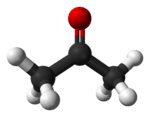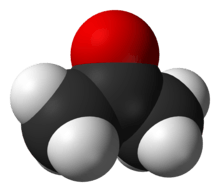Deuterated acetone
| |||
 | |||
| Identifiers | |||
|---|---|---|---|
| 666-52-4 | |||
| 3D model (Jmol) | Interactive image | ||
| 1702935 | |||
| ChEBI | CHEBI:78217 | ||
| ChemSpider | 455535 | ||
| ECHA InfoCard | 100.010.514 | ||
| EC Number | 211-563-9 | ||
| PubChem | 522220 | ||
| UN number | 1090 | ||
| |||
| |||
| Properties | |||
| C32H6O | |||
| Molar mass | 64.1161 g mol−1 | ||
| Density | 0.872 g cm−3 | ||
| Melting point | −94 °C (−137 °F; 179 K) | ||
| Boiling point | 56 °C (133 °F; 329 K) | ||
| Vapor pressure | 24.5-25.3 kPa (at 20 °C) | ||
| Hazards | |||
| EU classification (DSD) |
| ||
| R-phrases | R11, R36, R66, R67 | ||
| S-phrases | S9, S16, S26 | ||
| NFPA 704 | |||
| Flash point | −19 °C (−2 °F; 254 K) | ||
| Related compounds | |||
| Related compounds |
Acetone | ||
| Except where otherwise noted, data are given for materials in their standard state (at 25 °C [77 °F], 100 kPa). | |||
| Infobox references | |||
Deuterated acetone ((CD3)2CO) is a form (called an isotopologue) of acetone (CH3)2CO in which the hydrogen atom ("H") is replaced with deuterium (heavy hydrogen) isotope ("D"). Deuterated acetone is a common solvent used in NMR spectroscopy.
This article is issued from Wikipedia - version of the 6/24/2015. The text is available under the Creative Commons Attribution/Share Alike but additional terms may apply for the media files.


